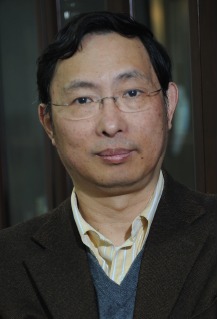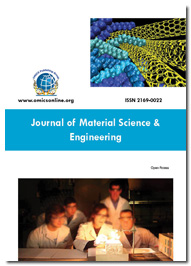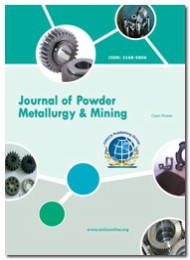Theme: Emerging Advancements in Smart Material Applications
Smart Polymer Tech 2019
ME Conferences organizes 300+ conferences, 500+workshops and 200+symposiums on Clinical, Medicine, Pharma and Science & Technology. Materials Science events are every year across UK, Europe, Asia, Middle East, Australia and USA that support material engineering conferences from 1000 more scientific societies and Publishes 100+ open access journals which contain over 30000 eminent personalities, reputed scientists as editorial board members. Smart Polymer Tech 2019 comes under Materials Science conferences.
After overwhelmed success of the previous conferences, we are excited to announce that “6th World Congress on Smart Materials and Polymer Technology ” will be held on December 16-17, 2019 at Dubai, UAE. The theme of the conference is “Emerging advancements in Smart Material applications”. Smart Polymer Tech 2019 initiates a worldwide gathered materials science professionals to learn about the latest advancements and innovations, as well as the novel applications of smart emerging materials in materials science and polymer technology.
This conference provides a perfect symposium for scientists, engineers, directors of companies and students in the field of Materials Engineering, Nano Materials, Textile and Polymer engineering, Ceramics, Spintronics, Nanotechnology, Aerospace and automobile engineering, Dental Science, civil and architectural engineering, Sustainable technology, Physics, Chemistry and related fields to meet and share their knowledge. Smart Polymer Tech 2019 is a 2-day event offering the Exhibition at venue to showcase the new and emerging technologies and have wider sessions involving Keynote presentation, Oral, YRF (student presentation), poster, e-poster presentations. World-renowned speakers and eminent delegates across the globe attend the conference, to share their valuable presentation on the most recent and advanced techniques, developments and the newest updates.
On that note, Smart Polymer Tech 2019 invites all interested participants to consolidate us for this honored event at the gorgeous destination Dubai, UAE. For more information: ME Conferences
Why to attend?
Smart Polymer Tech 2019 offers a fantastic opportunity to meet and make new contacts in the field of Materials Science and Engineering, by providing collaboration spaces and break-out rooms with tea and lunch for delegates between sessions with invaluable networking time for you. It allows delegates to have issues addressed on Smart and Emerging Materials, Materials Science and Polymer Technology by recognized global experts who are up to date with the latest developments in the Materials Science field and provide information on new techniques and technologies. This International Materials Science conference will feature world renowned keynote speakers, plenary speeches, young research forum, poster presentations, technical workshops and career guidance sessions.
Target Audience:
- Materials Science Engineers
- Nanotechnology Engineers
- Polymer Technologists
- Researchers from Mining and Metallurgy field
- Scientists and students from Tissue Science engineering and Biomaterials
- Delegates from Materials Science and Nanotechnology Associations
- Professors, Students, Researchers and Technical Staff from Materials Science and Nanotechnology Department
- Delegates from Materials Science, Semiconductor, Polymer, Fuel Cell and Energy related industries.
- Researchers and scientists from sustainable energy and development societies
- Fashion designers working on wearable technology
- Architects, Civil and structural engineers
- Delegates from aerospace, defense and automobile industries
The joy of attending Smart Polymer Tech 2019 brings with it improvement and incremental growth in your approach to do things, in the broader manner to see things and the beauty to live international diversity.
Come be Part of it...
Session 1: Emerging Smart Materials and Structures
The medieval ages where stone, bronze, steel was used have now led to growth of Ceramics, Minerals from where Metallurgy field aroused. Physics, Chemistry, thermodynamics and several other fields of science have researched metals, alloys, silica and carbon nanomaterial. Material Science has now revolutionized from metals and alloys to semiconductors, plastics, biomaterials, rubbers, polymers, magnetic materials, medicinal implant materials, nanomaterial etc. and it doesn’t stop there yet! Smart structures are devices composed of smart materials capable of sensing stimuli, responding to it and reverting to its original state after the stimuli is removed. Self-Healing Materials, Magnetocaloric and thermoelectric materials, Polycaprolactone are emerging smart structures. Smart structures have the ability to resist natural calamities. Several materials like LiTraCon, Silicene, Aerogels, Graphene, Fullerene, Metamaterials, Quantum Dots and Lithium Ion Batteries have been emerging. These emerging smart materials have found potential applications in health, aerospace, automotive industry etc.
- Magneto caloric and thermoelectric materials
- Self-Healing materials
- Photomechanical materials
- Shape Memory Alloys
- Piezoelectric and electroluminescent materials
- Chemochromic and electrochromic materials
- Conductive Polymers
- Aerogels and Quantum Dots
- Graphene and Carbon Nanotubes
- Fullerene and Metamaterials
-
Dielectric Elastomers
Session 2: Materials Science and Engineering
The discipline of science emerged by fusion of metallurgy, ceramics, solid-state physics and chemistry is the field which deals with identification, study and design of materials. To understand ancient phenomenon in mineralogy and metals , researchers combined the knowledge of physics, chemistry and engineering which led to development of new field in science namely Material Engineering or Material science. The bonding nature, shape, form, magnetic, chemical, optical, electrical, thermal, physical and several other properties of a material is discovered and studied in this field. The discipline is important both from a research perspective, as well as from an industrial one. When finding new materials, one encounters new discoveries which is yet to be discovered hence study and usage of the appropriate materials is crucial when designing systems.
- Design and Processing of Materials
- Crystallography
- Electronic and Photonic Materials
- Nanotechnology
-
Green technology
Session 3: Carbon nanotubes, Graphene and Composites
Carbon has long progressed from an element to diamond, graphite, carbon nanotubes and graphene. Carbon Nanotubes are carbon allotropes with cylindrical nanostructure and unusual properties finding applications in electronics, nanotechnology and optics. Graphene is another carbon allotrope with a hexagonal lattice structure having many types like Bi-layer graphene, Penta-graphene etc. majorly used as graphene biosensors. Composites (Composite Materials) are materials formed by the combination of 2 or more materials to have better characteristics compared to individual components. Composite materials fabrication varies for different composites like Nano composites, Textile composites etc.
- Different Production Methods
- Materials Physics and Chemistry
- Properties of Carbon nanotubes, Graphene and Composites
- Applications of Carbon nanotubes, Graphene and Composites
-
Toxicity of Graphene
Session 4: Material Synthesis and Characterization
Manufacturing materials with desired structure and properties involves the use of several different processing steps. As a material researcher, the structure, property and processing of a material (Materials Paradigm) must be known. The material cannot be manufactured in industry and marketed if no economical and qualitative production method for it has been developed. Thus, the processing of materials is vital to the field of materials science. The materials paradigm helps in forensic engineering, failure analysis, and investigation of aviation accidents. Recently several smart materials have emerged through new production methods or modified synthesis steps.
- Metals Synthesis
- Polymers Synthesis
- Ceramics and Textiles Synthesis
- Synthesis of Thin Films and shape memory alloys
-
Piezoelectric Materials Synthesis
Session 5: Spintronics
The search for materials with better optical, magnetic and electronic properties still continues by energy, semiconductor and electronics industries. Spintronics or spin electronics varies from traditional electronics due to the exploitation of the electron spins which happens to attain better material with data storage efficiency and transfer. Quantum Dots are emerging smart materials widely employed in the research of spintronics and quantum computing which has led to concept of dilute magnetic semiconducting quantum dots (DMSQDs).Graphene produced by chemical vapour deposition has also been employed by spintronics for its electron spin behaviour. The synthesis, significance and application of smart materials for fabrication of spintronics devices are discussed under this track.
- Spin detection techniques
- Semiconductor based spintronic devices
- Graphene and Quantum Dots in Spintronics
- Multi and Nano scale Modelling for the Materials Improvement and Design
-
Synthesis and Applications of Spintronic devices
Session 6: Surface Science and Engineering
Surface Science and engineering is the field of science which deals with the study of the material surfaces and interfaces seeking to control and optimize the properties of a materials surface like corrosion, wear resistance, biocompatibility etc. Material physics, Materials chemistry and corrosion engineering comes into picture. Many technologies and fields like Si device technology, MEMS, biomaterials, nanomaterials, aerospace and automotive engineering employ surface engineering principles for better coatings on materials.
- TCAD and Silicon surface functionalization
- Coatings production and specialization
- Surface Coating and Modification
- Coating Evaluation Tests
- Nanoscale Surface Modification
- Biomaterials Surfaces
-
Bioengineering
Session 7: Optical, Magnetic and Electronic Materials
Optics, Magnetic and Electronic materials research combines the principles from several fields of science like solid state physics, chemistry, materials science, electronic and chemical engineering. Magnetic materials will be researched and employed in data storage, super magnetism and spintronics field where as electronic materials will find applications in electronic, semiconductor and energy industries as dielectrics, nanomaterials / photonic materials and piezoelectric. Various materials like glasses, ceramics, dielectrics, semiconductors, Nano composites and polymer fibers have their optical properties modified to meet demands from energy sustainability, national security and commercial sector.
- Optoelectronic materials
- Magnetic materials
- Photonics materials and devices
- Lasers and optical materials
- Semiconductors and superconductors
- Smart Sensors and actuators
- NEMS, MEMS and liquid metal devices
- Stretchable and flexible electronic materials and devices
- Piezoelectric and ferroelectric materials
-
Nano-Optics, Nano-Photonics and Nano-Optoelectronics
Session 8: Nanomaterials and Nanotechnology
Nanotechnology is rapidly developing and merging with the materials science field. Smart Materials or Nanomaterials synthesis in Nanotechnology level can have different properties finding their applications in healthcare, construction and materials industry. Nanomaterials could be nanoparticles, nanopowders, nanodevices, nanofibers, nanosensors, nano crystals, Nano robotics, nanofilms, nanozymes, nanoelectronics, nanostructured multiphase alloys, nano sensors, nano computers and nano machines, nano devices, nanosystems and nanocomposites.
- Nanotechnology in Materials Science
- Synthesis, Characterization and Applications
- Carbon and Polymeric Nanomaterial
- Quantum Mechanics for Modelling of nanomaterial
- Mechanics of Nano materials
- Software for Modelling of nanomaterial
- Industrial Applications of Nano materials modelling
-
Nano Computational Modelling
Session 9: Piezoelectric Materials and 3-D Printing
Peizoelectric materials are smart materials which accumulate electric charge across the material surface upon mechanical stress and this charge can change the shape of the material. Some of these materials are quartz, ceramic, quantum dots etc. These electronic materials are used as sensors and actuators in automotive industries.
Rapid prototyping, 3dimensional (3D) printing or Additive manufacturing (AM) of smart materials like smart nanocomposites, shape memory alloys, ceramics, shape memory polymers, actuators for soft robotics, self-evolving structures, anti-counterfeiting system has been going on and 4D printing has also come into picture to include the structural reconfiguration of materials over time.
- Synthesis and Characterization of Peizoelectrics
- Applications of Peizoelectric devices
- 3D printing of Smart Materials
- Research in 4D printing of Smart Materials
-
Challenges, Applications and Future of 4D printing
Session 10: Biomaterials and Tissue Engineering
Biomaterials are medical materials ranging from contact lenses to implants and prosthetics intended to be used in healthcare and mostly tissue engineering as materials which can be introduced to the body as part of a medical device or organ replacement for bodily function. Tissue engineering combines cells with synthetic materials to generate artificial tissues. It focusses on materials for bone, cartilage and connective tissue repair. Currently nano-structured scaffolds, polymers, bio composites, bioactive fibres, bioactive soluble glass particles, nanoparticles and other smart materials are employed with medical or other technological applications.
- Bioinspired and Biomimetic Materials
- Tissue engineering biomaterials
- Structural and Functional biomaterials
- Materials for disease diagnosis
- Materials for pharmaceutical products and drug delivery
- Materials for medical devices
- Smart materials for body implants and prosthesis
- Smart biosensors and devices
-
Structural health monitoring
Session 11: Materials in Dentistry and Healthcare
The search for ideal restorative material for dentistry gave hope for applications of smart materials in dental science. Smart Materials are materials whose properties can be altered in controlled fashion to support the tooth structure. Smart Biomimetic materials can mimic enamel or dentin. The use of smart materials like smart composites, smart ceramics, resin modified glass ionomer, amorphous calcium phosphate releasing pit and fissure sealants, orthodontic shape memory alloys, smart impression material, smart suture, smart burs, etc. have revolutionized dentistry and maximized the advantage of conventional restorative techniques. Smart Materials have also found their applications in healthcare sectors as implants, biosensors etc.
- Dental Implants and composites
- Biomimetic and Bioactive materials
- Smart Composites and Ceramics
- Shape Memory Alloys
- Smart Fibres and Ceramic Braces
- Self-Healing Composites
- Smart Materials in Dentistry
-
Smart Materials in Healthcare
Session 12: Polymer Science and Engineering
Polymer science and engineering is the field of science which studies the synthesis and applications of polymeric materials (polymers). Crystallization and Polymerization of polymers, Polymer Nanotechnology, Materials Science and Electronics study and apply polymers in several applications such as lithium-ion polymer battery (LiPo), electro active polymers, polymer brush, self- assembled polymeric films, Silicon Nano spheres, collagen, enzymes, elastin, cellulose, chitin, plastics, fibres and adhesives. Smart Materials like thermoelectric materials, self-healing and shape memory polymers have also come under research in this field.
- Polymeric Materials
- Composite polymers and Biopolymers
- Organic polymer chemistry and Polymer engineering
- Polymers for biomedical applications
- Polymers for textile and packaging
- Functional Polymers and Polymer Hybrid Materials
- Polymers for Energy storage & Energy Harvesting
- Polymer Catalysts and Polymer Characterization
- Polymer Electrolyte Fuel Cells
-
Polymer Electronics and Polymer Coatings
Session 13: Ceramics and Textiles Industries
The earlier brittle materials which were hard and strong in compression and weak in tension and shearing were ceramics. To improvise their properties, smart materials were incorporated into them which led to development of smart ceramics which are ceramic materials fabricated from ultrafine particles using sol gel route. Smart Ceramics find applications in bone surgery, tissue engineering, dental applications, bio imaging, sensors, paints and pigments, optics, and electronics, drug and antigen delivery.
Smart Materials are also employed on textile industries. Smart Textiles or Textile materials are mainly designed to meet the requirements of the society like generation of power in fabrics, Moisture, temperature, Sweat and Smell control in clothing etc. Some of the modern materials in textiles are Kevlar, Polartec, Nomex, Neoprene, Polar fleece, Gore-Tex. Micro fibre, Micro encapsulation, thermochromatic, light sensitive and heat sensitive materials and methods are also employed.
- Synthesis and Applications of Ceramics
- Porous nanostructured ceramics
- Bioceramics and multifunctional nanoceramics
- Bioactive and transparent ceramics
- Smart and Interactive Textiles
- Thermochromic and Photochromic materials
- Micro encapsulated fabrics
- Thermochromic and Fluorescent printing dyes
-
E-textiles and wearable technology
Session 14: Materials in Aerospace and Defence
Smart Materials like piezoceramic materials, laminated composites etc. are used in aerospace industries to control the vibration in an aircraft component, de-ice the aircraft surfaces and for active control of broadband excitations. The smart advanced materials are designed for several functions in aerospace and defense. The functional materials are structurally designed to tailor thermal and electromagnetic characteristics and optimize the strength, weight, thermal, electromagnetic and stealth properties of a drone aircraft for aerodynamic and aero acoustic performance improvement.
- Advanced and Composite materials
- Aerospace Coatings
- Physical Vapour Deposition
- Ignition-Resistant Magnesium Alloys
- Sea Defense Systems against Raising Sea Levels
-
Research and Challenges
Session 15: Materials in Automotive and Construction Industries
Smart Materials give huge hope to automotive industries for their ability to incorporate intrinsic sensing and actuating capabilities into structural elements of vehicles. They have the ability to change shape, position, stiffness, fluid flow rate, damping in response to change in temperature, electric and magnetic field hence smart materials like piezoelectric ceramics, shape memory alloys, magnetostrictive materials, optical fibers, electrorheological fluids, magnetorheological fluids, conducting polymers and so on, find automotive applications as sensors, actuators and so on. Smart Materials are also researched in civil and structural engineering field to employ them in construction industries. Some such materials are carbon fibers, smart concrete, antimicrobial coatings, shape shifting metal and self-healing coatings to deliver functions like self-dimming and self-cleaning of glass, self-healing of construction materials etc.
- Mass Transit and Automotive
- Sensors and Machinery devices
- SMA actuators and pH sensitive polymers
- Peizoceramic based ultrasonic motors
- Electrochromic rear view mirrors and panaromic roofs
- Electroluminescent chromogenic surfaces
- Thermoelectric multifunctional car seat
- Carbon fibres and polymers
- Smart Concrete
- Antimicrobial and Self-Healing coatings
-
Smart Nanomaterials in Construction
Session 16: Sustainable Energy and Development
Depletion of natural resources and worldwide increase in population has created a global demand for energy. Materials are hope for renewable energy sources, super capacitors, energy storage in batteries, thermoelectric devices, energy conversion through solar cells and fuel cells. For the growing need of production and energy storage, systems including diverse materials, operations and properties have been employed, for example batteries such as Lithium batteries are used in various types of mobile devices, including communication equipment, computers, entertainment devices, power tools, toys, games, lighting and medical devices. Semiconductor devices have replaced vacuum tubes and from these semiconductor materials diodes, transistors, light emitting diodes (LEDs) have emerged for energy efficiency. Materials with emerging energy technologies are the supportable energy foundations to withstand the geophysical alteration. Solar energy is the superior and the development of photovoltaic cells is needed for the existing development. The piezoelectric, ferroelectric materials and thin films are the valuable materials for the conversion of energy. Smart materials employed in smart tools for wide range of energy applications, energy efficiency and sustainability have huge possibilities in the coming future.
- Semiconductors and Super capacitors
- Peizoelectrics
- Photovoltaic materials
- Hydrogen Storage Materials
- Fuel cells and Smart grid
- Solar cell materials and devices
- Advanced battery technologies
-
Sustainability of Materials
Session 17: Architecture Materials and Wearable Technology
From the metallic alloys employed in domestic uses as utensils to the iron alloys employed in industries and construction, From a brittle glass to a scratch resistant corning gorilla glass, From furfural to composites, From new semiconductor materials to smart wearable technology it has become smarter lifestyle. Clothing with in build technology devices like music players are wearable technologies which are defined as Electronic or E-textiles. Smart Materials are utilized in this technology to make comfortable clothing.
Smart Materials are also researched in construction and architecture sectors. Color changes, physical states, temperature or shape of the smart materials make them attractive towards architects for instance thermochromic urban seats that reflect people’s presence, wallpaper with organic patterns that glow in darkness, electrochromic glass and so on. An application of smart materials in architecture is progressing to meet the beautiful and a quality standard of a lifestyle which is closely followed with wearable technology.
- Wearable electronics
- Kevlar, NanoGrain and Lifeshirt
- Micro encapsulated fabrics
- Electrochromic glass
- Thermochromic materials
- Shape-shifting smart materials
- Power generating smart materials
- Self-maintenance smart materials
-
Smart materials providing high level of insulation
Session 18: Market Demand and Future
Smart Materials and Structures market is expected to cross more than $40billion in the upcoming years and the market is segmented by products, end user industry applications and geography. The R& D investment in industries, the support of government, the research in several universities and the adoption of smart material products in several sectors like Defense & Aerospace, Automotive, Healthcare and Consumer electronics has driven the market of smart materials. Future for these emerging materials holds several promises in several fields of applications like energy, architecture, textile, ceramics, Automotive, Aerospace, Appliance, Medical and Electronics industries.
- Government Initiatives and Incentive Programs
- Substantial Investment in R&D
- Market Segmentation
- Current Research and Patents
- Scope for Research and Patents
- Futuristic Applications
Relevant Conferences:
Material Science Conference | Smart Material Events | Mechanical Engineering Conferences | Ceramics Congress | Materials Chemistry Meetings | Polymer Conferences | Aerospace Event | Biomaterials | Nano-materials
- Advanced Materials Conference September 26-27, 2019 at Dubai, UAE
- Materials Electrochemistry Conference January 28-29, 2019 at Abu Dhabi, UAE
- Materials Science and Engineering Conference October 14-15, 2019 at Bali, Indonesia
- Polymer Sciences Conference November 18-19, 2019 at Helsinki, Finland
- Structural Materials Conference, November 12-13, 2018 Melbourne, Australia
- Biomaterials Conference, February 25-26, 2019 London, UK
- Materials Research Conference, February 18-20, 2019 Amsterdam, Netherlands
- Emerging Materials Conference, March 07-08, 2019 Berlin, Germany
- Sustainable Technology Conference April 08-09, 2019 Toronto, Canada
- Smart Material Congress July 08-10, 2019 Prague, Czech Republic
- Smart Materials and Structures Event August 01-02, 2019 Dublin, Ireland
- Innovative Materials Conference February 27-28, 2019 Berlin, Germany
- Smart and Emerging Materials Congress, January 31- February 01 2019, Singapore
- Smart Material Applications Conference January 19-22, 2019 Tokyo, Japan
- Smart Materials Engineering and Technology Event January 24-25, 2019, Paris, France
- Polymer Chemistry Conference June 12-13, 2019 Montreal, Canada
- Polymer Science Conference July 30-31, 2019 Amsterdam Netherlands
- Polymer Technology Congress June 10-11, 2019 Berlin, Germany
- Polymer Science and Technology Event November 25-26, 2019 Miami, USA
Related Societies:
Europe: Federation of European Materials Societies (FEMS), European Association for Structural Dynamics , the Thermal Spray Society, International Magnesium Association, International Society of Coating Science and Technology, The International Thermal Spray Association, International Titanium Association, International Union of Materials Research Societies, Magnetic Materials Producers Association, National Society of Professional Engineers, SAE International, Semiconductor Research Corporation, Society of Engineering Science, UK Society for Biomaterials, Materials Research Society, Non-Ferrous Founders' Society, Royal Microscopy Society, Society for Biomaterials, Institute of Materials, Minerals and Mining (IOM3)
USA: Alpha Sigma Mu, American Ceramic Society(ACerS), American Chemical Society (ACS), American Institute of Chemical Engineers (AIChE), American Society for Engineering Education(ASEE), American society for Non-Destructive Testing(ASNT), American society of Mechanical Engineers(ASME), American Welding Society(AWS), U.S. Council for Automotive Research, NACE International, The Corrosion Society, The American Society for Testing of Materials, American Institute of Physics, American Powder Metallurgy Institute, American Society of Body Engineers, American Society of Civil Engineers, American Vacuum Society, American Welding Society, American Founders men's Society, American Institute of Aeronautics and Astronautics, Canadian Biomaterials Society
Asia Pacific: Association For Manufacturing Technology, Association of Vacuum Equipment Manufacturers, Abrasive Engineering Society, International Organization of Materials, Metals and Minerals Societies, International Union of Crystallography, International Union of Materials Research Societies, Materials Research Society, National Materials Advisory Board, Society for Mining, Metallurgy, and Exploration , Society for Biomaterials, Japan Society for Composite Materials, Society of Materials Science, Federation of Materials Societies, International Union of Crystallography, Bureau of International Recycling, Cast Metal Institute, Casting Industry Suppliers Association, Ductile Iron Society, Electrochem Society, Electronic Device Failure Analysis Society, Society for the Advancement of Material and Process Engineering, Society of Materials Science, International Union of Crystallography, The Minerals, Metals and Materials Society, The National Association of Corrosion Engineers, Engineer's Week, International Union of Crystallography, International Union for Biomaterials Science and Engineering(IUSBSE), Society for Biomaterials, Society for the advancement of Material and Process Engineering, Society of Material Science, Sigma Xi: The Scientific Research Society, International society for Optical Engineering, Australasian Society for Biomaterials and Tissue Engineering , Australasian Ceramic Society, Brazilian Composite Materials Association
ME Conferences is glad to welcome you all for the upcoming “6th World Congress on Smart Materials and Polymer Technology ” which will be held on December 16-17, 2019 at Dubai, UAE. The theme of the conference is “Emerging Advancements in Smart Material Applications”. Smart Polymer Tech 2019 provides a platform for materials science and smart material researchers to learn about the latest development, different synthesis methods and the applications of smart materials and technologies in several sectors.
Conference Highlights:
- Emerging Smart Materials and Structures
- Materials Science and Engineering
- Carbon nanotubes, Graphene and Composites
- Material Synthesis and Characterization
- Spintronics
- Surface Science and Engineering
- Optical, Magnetic and Electronic Materials
- Nanomaterials and Nanotechnology
- Piezoelectric materials and 3-D printing
- Biomaterials and Tissue Engineering
- Materials in Dentistry and Healthcare
- Polymer science & engineering
- Ceramics and textiles industries
- Materials in aerospace and defence
- Architecture Materials and Wearable technology
- Materials in automobile and construction industries
- Sustainable energy and development
- Market Demand and Future of Materials
Important and scope:
Material science has always been with us from the ancient times and has always been the backbone of human’s evolution and development. Materials scientists lay stress on understanding how the history of a material influences its structure, and thus its properties and performance. All this factors have paved way for the improvement of the quality of human life to a great extent. Smart and Emerging Materials 2019 gives you the in-depth analysis of material science and new definition to your imaginations. It gives you the base to build your own castle of knowledge and make you completely ready, preparing you for the challenges in material science Industry and growing yourself with the abundant knowledge on emerging smart materials.
Why Dubai, UAE?
Emerging Smart Materials research and market is rapidly growing all over especially with a renewed interest in Dubai where architecture and industrial revolution is happening in a faster pace. The conference aims to develop material science and smart materials research in Dubai, balancing the growth of the industrial sector in the country. Recently Dubai has emerged in material science and polymer technology sector due to the interest, education, investments and research.
Why to attend?
Smart Polymer Tech 2019 paves a platform to globalize the research by installing a dialogue between industries and academic organizations and knowledge transfer from research to industry. Smart and Emerging Materials 2019 aims to proclaim knowledge and share new ideas amongst the professionals, industrialists and students from research areas of Materials Science, Polymer Science, Ceramics and Smart Textiles, Nanotechnology, Architecture, Civil and structural engineering, Aerospace and automotive engineering to share their research experiences and indulge in interactive discussions and special sessions at the event.
Applications of Smart Materials in Different Fields:
Materials Science is a broad field of study involving several branches of science namely metallurgy, mining, Physics, Chemistry, Nanotechnology, Biomaterials, Ceramics, Polymer science etc. Smart Materials are emerging field in Materials Science and their applications and their development, application involves several aspects too. According to the research and market reports, the smart material applications is observed in 3-D printing, coating science, Aerospace, Automotive, Construction, Energy industries and many segments. It can be observed in the following graph.
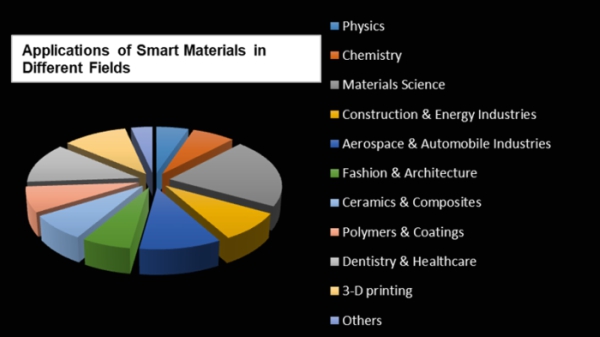
Growth Statistics of Smart Material Application:
As per the market growth of smart material application in USA and Europe the market value is expected to cross more than 4billion USD within the coming years. Finland is one developed country which is showing profitable economic growth in industry to be part of the European Union Market. Finland so far has shown tremendous growth in material science and technology, mobile technology, novel materials development and related hardware research and it is expected to be one of the leading country in Eastern Europe for skilled labor force, investments and economy.
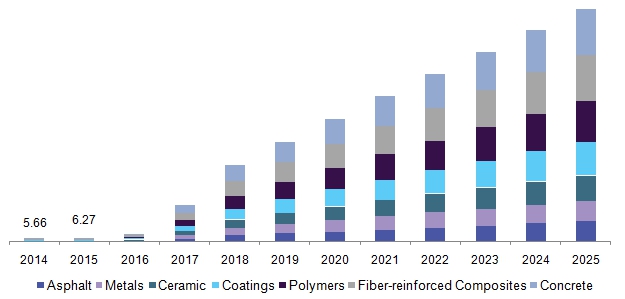
Major Associations and Societies around the Globe:
- Materials Research Society
- Society for Biomaterials
- American Chemical Society (ACS)
- American Physical Society (APS)
- The Materials Information Society (ASM International)
- Microscopy Society of America (MSA)
- The Minerals, Metals & Materials Society (TMS)
- Sigma Xi: The Scientific Research Society
- International Society for Optical Engineering (SPIE)
- The American Ceramic Society
- International Union of Pure and Applied Physics (IUPAP)
- Federation of European Materials Societies (FEMS)
- Institute of Cast Metals Engineers
- Asia Pacific Society for Materials Research (APSMR)
- International Association of Advanced Materials
- Association for Iron & Steel Technology (AIST)
- ASTM International
- Institute of Materials, Minerals and Mining (IOM3)
- Society for the Advancement of Material and Process Engineering (SAMPE)
Major Associations in Materials Science:

Major Universities in Material Science:

Global Market at a Glimpse:
The adaptive or intelligent materials which have intrinsic and extrinsic capabilities are smart materials which have the highest market demand and future in materials science on account of emerging economy and evolution in IOT. Their market value is expected to reach $70+ billion by 2022. Based on application the smart materials are majorly used as transducers, actuators & motors, sensors, structural materials and coatings. Smart materials will mostly find their applications in end user industries like industrial, defence & aerospace, automotive, consumer electronics, healthcare and others (civil engineering and retail). The global smart material market will be distributed in North America, Europe and Asia Pacific.
Conference Highlights
- Emerging Smart Materials and Structures
- Materials Science and Engineering
- Carbon nanotubes, Graphene and Composites
- Material Synthesis and Characterization
- Spintronics
- Optical, Magnetic and Electronic Materials
- Nanomaterials and Nanotechnology
- Piezoelectric Materials and 3-D Printing
- Biomaterials and Tissue Engineering
- Materials in Dentistry and Healthcare
- Polymer Science and Engineering
- Ceramics and Textiles Industries
- Materials in Aerospace and Defence
- Architecture Materials and Wearable Technology
- Materials in Automotive and Construction Industries
- Sustainable Energy and Development
- Surface Science and Engineering
- Market Demand and Future
To share your views and research, please click here to register for the Conference.
To Collaborate Scientific Professionals around the World
| Conference Date | December 16-17, 2019 | ||
| Sponsors & Exhibitors |
|
||
| Speaker Opportunity Closed | |||
| Poster Opportunity Closed | Click Here to View | ||
Useful Links
Special Issues
All accepted abstracts will be published in respective Our International Journals.
- Journal of Material Sciences & Engineering
- Journal of Powder Metallurgy & Mining
- Journal of Nanosciences: Current Research
Abstracts will be provided with Digital Object Identifier by










